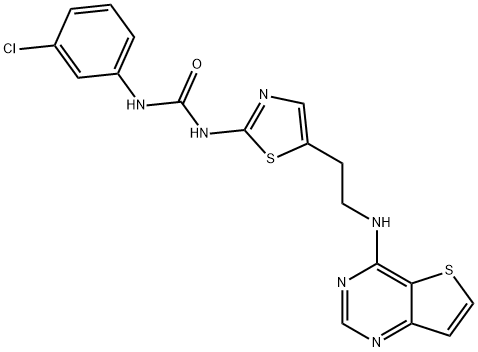All AbMole products are for research use only, cannot be used for human consumption.

In vitro: In HCT116 colorectal carcinoma cell line, with intact or depleted p53 protein levels, SNS-314 shows enhanced efficacy when administered sequentially with other standard chemotherapeutic agents and the most profound synergies are identified for agents that activate the spindle assembly checkpoint, e.g., docetaxel and vincristine. A recent study shows that SNS-314 shows potent antiproliferative activity in HCT116 cells and inhibits soft agar colony formation.
In vivo: The sequential treatment with SNS-314 followed by docetaxel 24 hours later produces a significant 72.5% tumor growth inhibition of HCT116 xenografts, while docetaxel and SNS-314 as single agents produce no significant inhibition of HCT116 tumor growth. In the HCT116 human colon cancer xenograft model, administration of 50 and 100 mg/kg SNS-314 results a dose-dependent inhibition of histone H3 phosphorylation, indicating effective Aurora-B inhibition in vivo. In addition, HCT116 tumors from animals treated with SNS-314 exhibits potent and sustained responses including reduction of phosphorylated histone H3 levels, increased caspase-3 and appearance of increased nuclear size.
| Cell Experiment | |
|---|---|
| Cell lines | HCT116 SCR and HCT116 p53 RNAi cells |
| Preparation method | Viability is measured using the CellTiter-Blue cell viability assay. Cells are treated as described above, although with a 5-day incubation period. Cytotoxicity is determined by measuring intracellular ATP using the CellTiter-Glo Luminescence Cell Viability Assay. Cells are seeded in white 96-well tissue culture plates at a density of 1.5-2 × 103 cells/well, and a serial dilution of SNS-314 is dosed in combination with fixed concentrations of either docetaxel or vincristine for a total of 72 hours. Viability is determined as the ratio between the ATP in treated cells versus control cells. Apoptosis is measured using the caspase-Glo 3/7 system. Cells are plated in white 96-well plates as described above and treated first with SNS-314 for 24 hours, washed with 200 μL of 1× PBS, and fresh medium is added with the second agent for 24 hours. |
| Concentrations | 125 nM |
| Incubation time | 48 h |
| Animal Experiment | |
|---|---|
| Animal models | HCT116 cells are injected s.c. into the right flank of nu/nu mice |
| Formulation | 20% Captisol R |
| Dosages | 42.5 mg/kg |
| Administration | i.p. |
| Molecular Weight | 430.93 |
| Formula | C18H15ClN6OS2 |
| CAS Number | 1057249-41-8 |
| Solubility (25°C) | DMSO 90 mg/mL |
| Storage |
Powder -20°C 3 years ; 4°C 2 years In solvent -80°C 6 months ; -20°C 1 month |
| Related Aurora Kinase Products |
|---|
| Phthalazinone pyrazole
Phthalazinone pyrazole is a potent, selective, and orally active inhibitor of Aurora-A kinase with an IC50 of 0.031 μM. |
| Aurora Kinases-IN-4
Aurora Kinases-IN-4 is a covalent and ATP competitive aurora kinase A inhibitor (IC50: 1.7 nM). |
| Derrone
Derrone, a prenylated isoflavones, is an Aurora kinase inhibitor, with IC50 values of 6 and 22.3 μM against Aurora B and Aurora A, respectively. Derrone shows anti-tumor activity. |
| CD532 hydrochloride
CD532 hydrochloride is a potent Aurora A kinase inhibitor with an IC50 of 45 nM. CD532 hydrochloride has the dual effect of blocking Aurora A kinase activity and driving degradation of MYCN. CD532 hydrochloride also can directly interact with AURKA and induces a global conformational shift. CD532 hydrochloride can be used for the research of cancer. |
| Aurora kinase inhibitor-2
Aurora kinase inhibitor-2 is a selective and ATP-competitive Aurora kinase inhibitor with IC50s of 310 nM and 240 nM for Aurora A and Aurora B, respectively. |
All AbMole products are for research use only, cannot be used for human consumption or veterinary use. We do not provide products or services to individuals. Please comply with the intended use and do not use AbMole products for any other purpose.


Products are for research use only. Not for human use. We do not sell to patients.
© Copyright 2010-2024 AbMole BioScience. All Rights Reserved.
